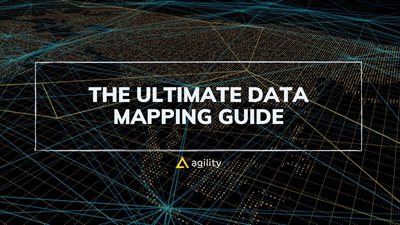Data Mapping Guide
Take control of your data with data mapping


Irrespective of industry, most businesses are now having to handle massive amounts of data, often complicated by a variety of sources. The sheer quantity and complexity can make organizing and untangling this data feel something like being a preschooler given a quadratic equation to solve.
As a result of this intricate web of data, there needs to be some kind of approach that can structure and organize even the most varied of data sets. This is particularly important when you also consider the impact that data itself can have on a business.
Data, and its intelligent use, can spur marketing choices, boost sales, provide insight into customer experience trends, and could even lead to a business rethinking its entire model (a drastic change you definitely don’t want to do if you are not 100% sure you understand the information).
Before we continue, it’s important to remember that how your company handles data should also be to ISO standard. This is particularly important given compliance legislation such as GDPR.
In order to take control of this increasingly complex data environment, many companies turn to data mapping.

The clue is in the name. Think of a map—it covers all of the geographical info you might need about a location in one place. Distance is clearly represented, services indicated, altitude, transport links, and terrain type all noted. The map simplifies the information, enabling it to all be accessed in one unified and central location.
A loose metaphor, but this enables us to visualize what we want to get out from data mapping. We want to simplify our data sets, and we want to see them all in the same place.
A deeper look into what data mapping is
When we are data mapping, we’re taking data of different forms from different sources or fields, and attempting to match them into a schema—the skeletal structure that represents the logical view of your database.

This process of homogenization can be complex. Data is spread between different sets and different sources and may be in different formats. It is the data mapping process’s job to find the connections and links between pieces of data and reorganize them.
Imagine you have three 1000-piece puzzles. Before you start to put them together, you need to identify the links between the pieces. Which puzzle does each piece belong to, is it a corner, an edge piece? You find common characteristics and categorize accordingly. Data mapping has a similar process. It seeks patterns, and maps according to these indicators, making the end result in something usable.
When the quantity of data isn’t too large, this can be a simple process. But as data sets have grown, the sources for data have multiplied, and the complexity of systems using the data has increased, data mapping has become increasingly difficult. It now often requires assistance through automation or AI for business process optimization, powerful tools, and of course relies on the all-important data centers.
Still, struggling to conceptualize this?
Imagine you’re a company offering business processing services. Your data may be sourced from a combination of your current client base, potential leads, and third-party data. As a result, the data collected will be varied. For example, you may have personal data such as names and demographics from all sources, but no indication of click-through rates on your website from third-party data.
Data mapping would involve identifying these categories within the data, and compiling it logically into one data set. If you wanted to see the business sectors your customers come from, you could find this out with ease in one location, regardless of where that data originally came from. This is invaluable to businesses as it makes it possible to view the company's total data assets all at once and make fully informed decisions.
The compilation of data is based on “rules” that dictate whether a piece of information falls into a certain category, and what should be done with it. This can help to weed out duplicates or incorrect information. It can also help to simplify the data. For example, data in monetary values can all be converted into a homogenous currency, to make comparison easier. Data that varies between percentage and decimal points can also be converted, in order to minimize confusion.
This example of data mapping is reasonably simple, with only a few datasets in play, and a few varieties of data types. The data mapping process increases in complexity as the number of datasets, the amount of data, the frequency of data mapping, and the number of schemas required increase.

Why is data mapping so important?
The answer is ultimately linked to the question “why is data so important?”.
You are presumably here, reading this article because you already know that data is crucial. Data helps businesses predict consumer behavior, improve and refine their decision-making, optimize their marketing strategy (and avoid content marketing pitfalls), and keep on top of trends and their return on investment.

If you were a company advertising that you sold the best management book, you would be substantiating this on data (hopefully, at least) and not just announcing that yours is the best without any basis. Perhaps it has the most sales comparatively, it is highly rated online, or people frequently share links to the book with their peers. This all produces data that enables you to identify your company strengths and market based on them, and can drastically improve your strategy.
Data mapping also helps your business at several different stages of the data flow within an organization—data integration, transformation, and storage.
What is data integration?
Data integration is the process of inputting data into a workflow or data warehouse. Mapping comes into use when the data you want to integrate is in a different form to the data being stored by the warehouse or workflow.
As previously touched on, the data is analyzed for its attributes and then matched to the warehouse schema, looking specifically for areas of overlap and defining rules for where there are issues with the data.
Just as software testing tools will analyze the aspects of the software that work and weed out the bugs that don’t, this process finds the data that is useful and decides what should be done with that which isn’t.
What is data transformation?
Data transformation is a key part of data integration. This is the point where data is converted into the necessary format or structure. This can make or break whether the data can be effectively analyzed, and is a really important step in the process.
An extremely simple example of this could be transforming information such as dates of birth into a numerical value. For example, from 25th November 1983 to 11/25/1983 or 19831125.

The how-to guide
Now it’s time to consider how to do data mapping right. This can seem like an overload of information, so we’re going to break down the how-to into clear and simple steps.
If you’re working on data mapping within a team, it’s also a good idea to have a clear idea of how you will organize team task management before you get started, to avoid the process getting messy.
Know your data
Have a clear definition of what the data is that you will be mapping. Think of this like laying out the ingredients in your recipe before you start baking. This is the point where you begin thinking about what you’re working with, and when it will need doing.
Remember, the frequency with which you plan to map your data, the more complex the process will be. Having this all planned out in advance is a way to get your head around it and simplify the process (as much as possible).
Know your rules (and transformations)
Layout how you want to deal with problems with the data and duplicates, as well as if any data will need to be transformed into a new format in order to work in the schema.
This, along with the details surrounding the data, will be useful to pass on to your team members. If data mapping at a complex level is new to your business, it is worth looking into some internal training. Due to the pandemic preventing in-person training in many cases, it could be a good idea to research virtual training best practices before implementing a complex new mapping system.
Testing
If you work in IT, you know the importance of testing in all things technological. Testing is what leads to new developments and innovations. For example, the move away from traditional CMS to headless CMS. The benefits of a headless CMS include enabling more flexibility across devices while being cheaper and easier to use. This is the kind of innovation that can come from product testing.
In terms of data mapping, the testing process will look like starting with a smaller dataset and running the workflow/mapping system. If the process runs smoothly and produces the results you’re looking for, you can start to input more datasets. As your input complexifies, you may need to update the mapping process and adjust accordingly.
The Techniques
While you may know the logical basis of the data mapping process, there are different tools and techniques you can use.
1. D.I.Y - manual data mapping
The clue is in the name. This is a technique of data mapping where the onus for creating the rules falls onto the developers. Developers will need to code connections in order to match the data from source to the schema, and every step of the process will be done by a human being.
For a one-off process or a small adjustment, sometimes doing things manually is a more convenient option. However, as your workloads increase, along with the complexity of the data being handled, manual data mapping methods could become extremely labor-intensive and inconvenient.
Manual data mapping can also increase the chances of mistakes being made due to human error, and fixing these problems can feel a little like attempting to weed your way through a thick jungle of data. In these cases, turning to an automated solution can be much more convenient.
2. Rely on the robots - automated data mapping
Of course, “robots” are an exaggeration. But the complexity of data with which automated mapping tools work can make it seem like the futuristic imagined possibilities for AI.
Automated tools simplify adding data to schemas, and usually make the process fully transparent for a company so the users can see the processes that the data is going through at every stage.
With large and complex datasets, automated data mapping tools are essential to ensuring smooth sailing with error-free end results. Plus, because it takes the complicated parts out of the employees’ hands, even non-technically trained staff can monitor and help set up the data mapping (even if they won’t necessarily then be the one to tinker with the system and get it working again.)
To summarize
Data mapping is all about recognizing patterns to make it easier to piece together your data puzzle. As to whether you should pursue data mapping manually or with an automated data mapping tool, it will depend on what you want to get out of the process. With smaller datasets, you can take on the task yourself, while large and complex databases may want to rely on automation to get the job done.
The important thing to remember is the importance of data mapping in general. Without data mapping, your business is facing the market blindly. You may have access to all the data in the world, but if you cannot effectively process and analyze it, it is all but useless.
Once you have put your data mapping process into action, you’ll be able to take information away from the data to help inform your decisions, from improving the UX of your product portfolio to adopting new sales techniques and adjusting your marketing strategy. The insight you gain as a result of a robust data mapping process can be paramount to the success of your company.
Bio:
Alister Esam - CEO and Founder, Process Bliss
Alister Esam is the CEO and Founder of Process Bliss, a business process software that is reinventing how businesses execute day-to-day tasks. He is an expert in strategic planning, business process management, and business process optimization. With more than 15 years of experience in helping businesses run at peak efficiency, Alister has dedicated his career to making work easier and more motivating for managers and employees alike. Here is his LinkedIn.

About the Author
Agility CMS is Canada's original headless CMS platform. Since 2002, Agility has helped companies across Canada and around the world better manage their content. Marketers are free to create the content they want, when they want it. Developers are empowered to build what they want, how they want.
- Get a demo for a personalized walkthrough.
- Try for FREE and experience Agility CMS.
- Contact us with your questions.




